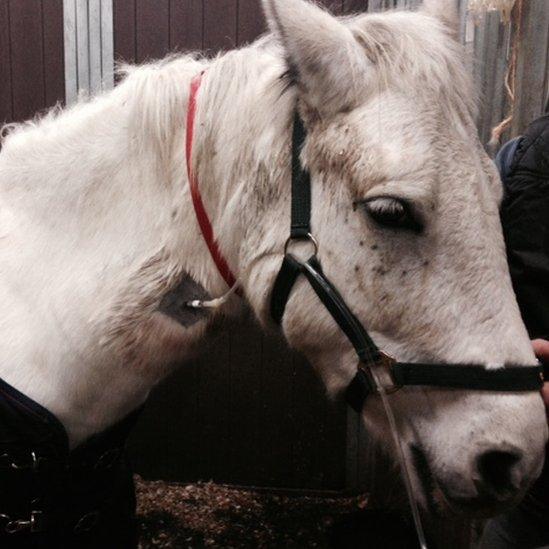Atypical myopathy: Rise of fatal horse condition 'linked to sycamore trees'
- Published

Hugo is being fed by drip feed at Tullyraine Equine Clinic, County Down
Horse breeders and owners are being forced to remove livestock from fields early due to a deadly disease that kills horses within a matter of hours.
Atypical myopathy has the same symptoms as colic and is linked to the leaves and seeds of the sycamore tree.
It is so rare it has not been seen in Northern Ireland for years.
However, since the beginning of October, there have been 10 cases in County Down so far. Six of the affected horses had to be put down.
The other four are believed to be recovering.
Pain
Good weather may have meant seeds have been able to lie on the ground longer and horses are eating them.
Bill Irwin is a horse breeder and trainer near Lisburn, County Antrim. He has had to put two of his horses down, including one he was grazing for a friend, after they became ill at his farm on the Ballymullan Road.
"It looked in the beginning as if they had colic symptoms when a horse starts to sweat and get stressed," he said.
"Subsequently, we took the normal action to make them walk and keep them moving which is what you do for colic. The second horse we were able to get to very, very quickly. We had him at the vet within an hour and the treatment started immediately.
"During the day he was on the drip but making very little progress and the next morning it was decided because he was not making progress and because he was in so much pain we would put him to sleep.
"We then sent him away by agreement with the vet to have a post-mortem examination and we haven't had the result back yet.
"We have sycamore trees in various fields in the farm. The two horses that were affected by it - one was on one side of the road and the other was near enough a mile away in another field. So it was completely different sycamore trees in completely different places and therefore it was a total surprise.
"We've now taken all the horses off the ground to avoid them getting anywhere near the sycamore trees. My main concern is what do we do in 2015 if we come to September - do we take them off the grass?
"This is the first time I've heard of such a thing as sycamore poisoning because we've been grazing the same fields for 44 years."
Tremors
Hugh Suffern is the owner of Tullyraine Equine Clinic in Banbridge. Has treated all the animals affected so far and is still drip feeding one horse that is continuing to show symptoms.
He says the disease is normally seen in England, Belgium and America but he has never seen a case in Northern Ireland before and has linked the good weather to the outbreak.
"It seems to be the toxin called Hypoglycin A which causes the poison. It can be found in sycamore seeds and can be very concentrated.
"The toxin disrupts muscle fibres and this can trigger muscle tremors or sweating. Horses may be unable to move or get up. Dark red, muddy-coloured urine is also a symptom," he said.
"The pastures are short, and as the horses graze they are picking up these helicopters and leaves," Mr Suffern added.
Meanwhile, the Department of Agriculture said it was not aware of the disease and had no cases to report.
However, a spokesperson suggested horse owners fence off areas where sycamore seeds and/or leaves have fallen, regularly inspect fields to ensure seeds have not blown in from nearby sycamore trees, supply extra forage (hay or haylage) especially where pasture is poor and if still concerned to contact their vet immediately.